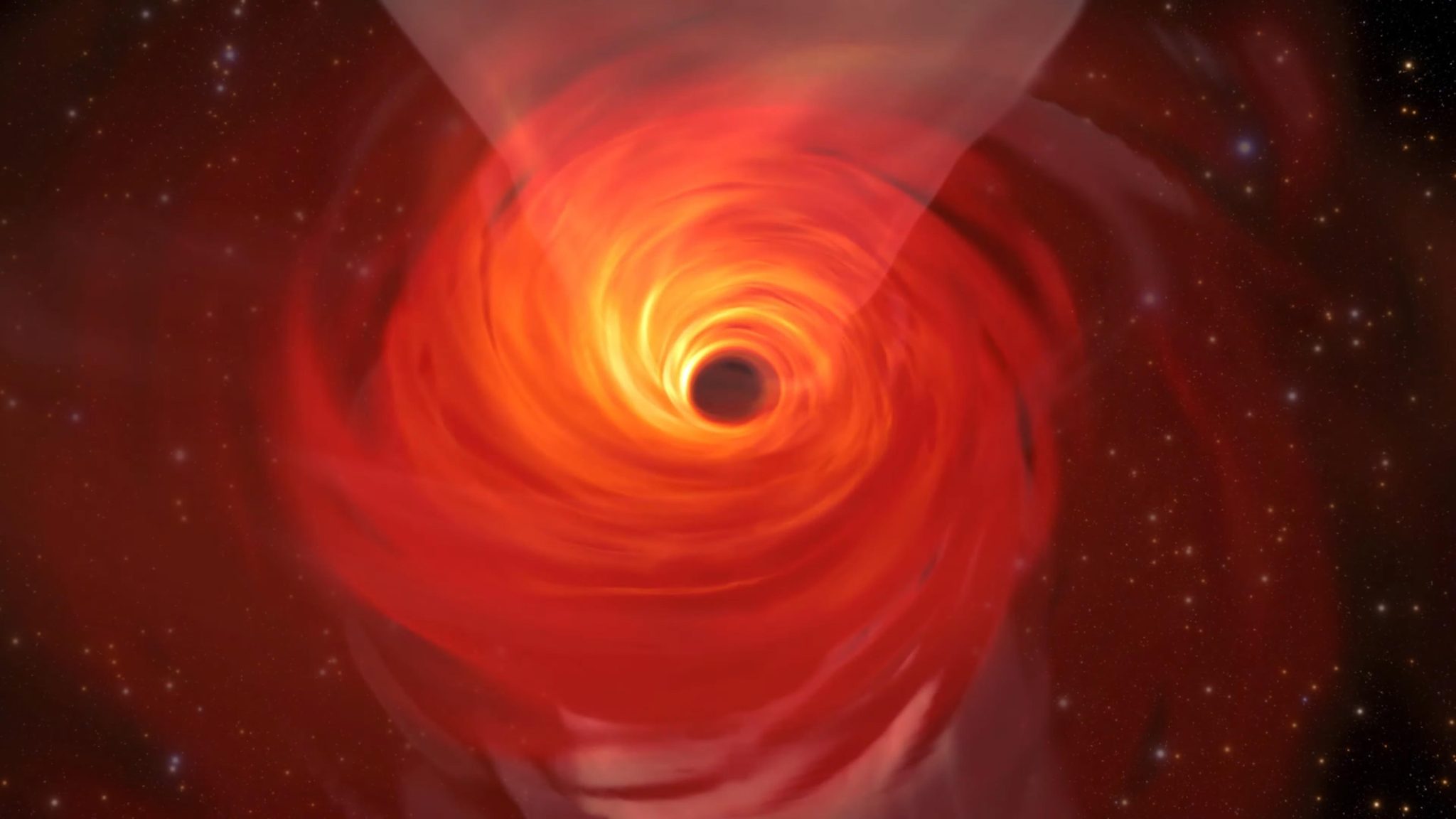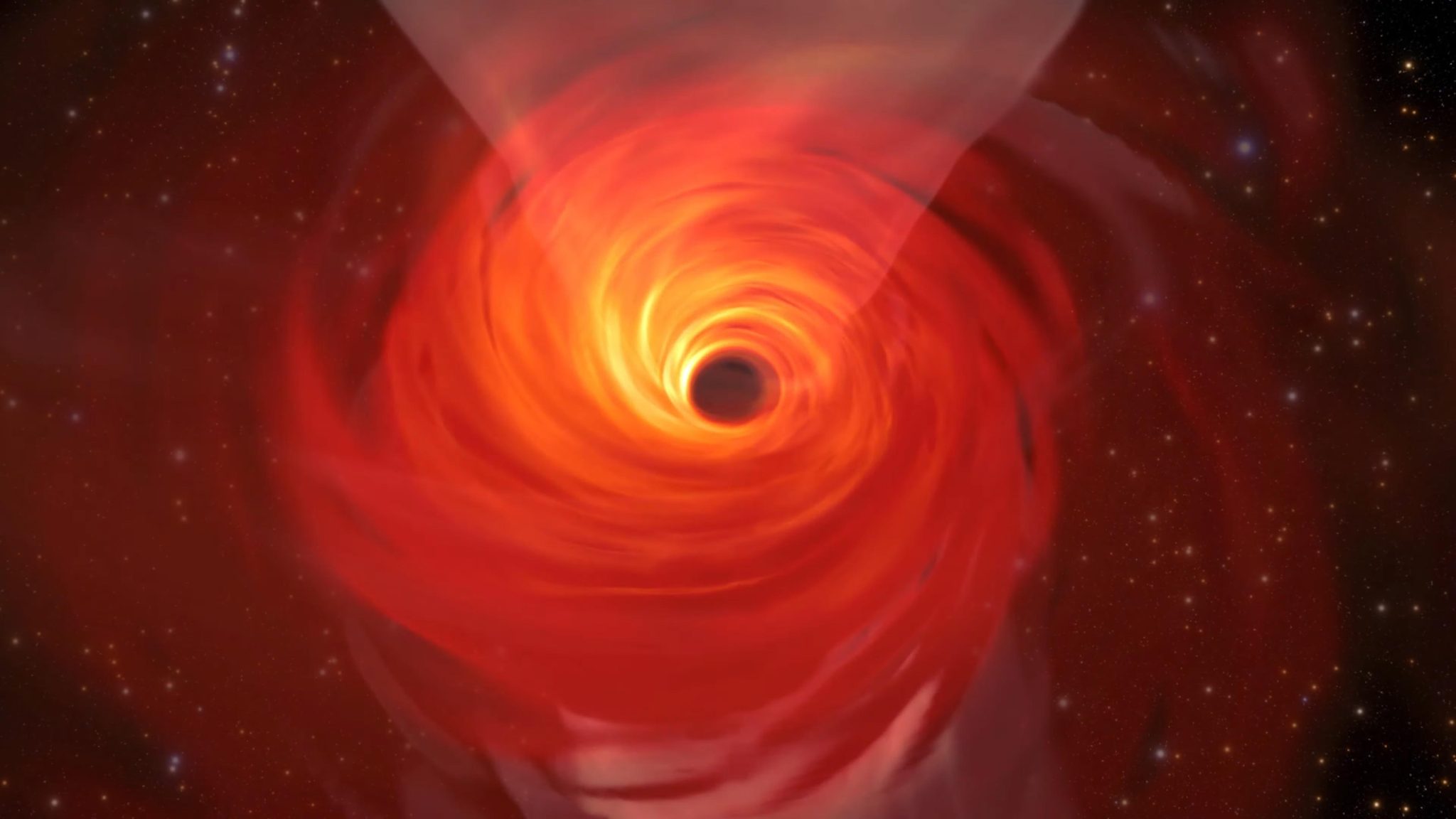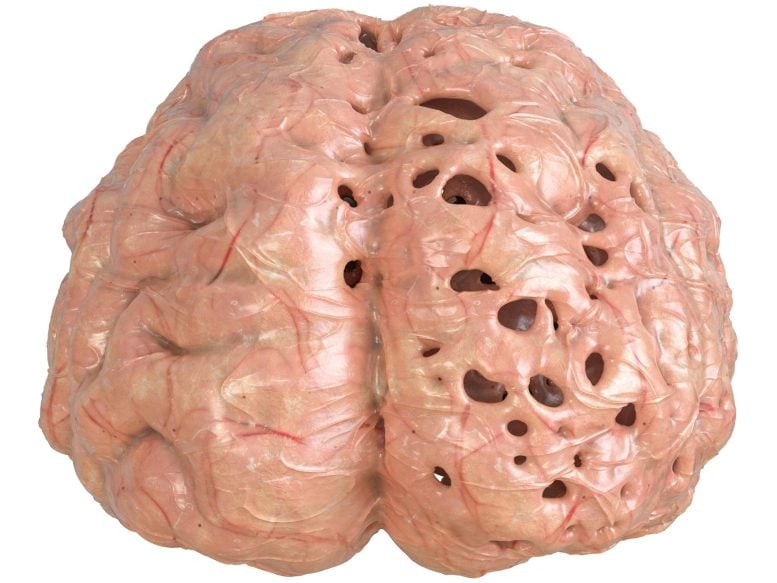
Οι αστρονόμοι εντόπισαν σημάδια ενός «καυτό σημείου» που περιφέρεται γύρω από τον Τοξότη Α*, τη μαύρη τρύπα στο κέντρο του γαλαξία μας.
Οι αστρονόμοι εντόπισαν σημάδια ενός «καυτό σημείου» σε τροχιά γύρω από τον Τοξότη Α*, και[{” attribute=””>black hole at the center of our galaxy, using the Atacama Large Millimeter/submillimeter Array (ALMA). The finding helps us better understand the enigmatic and dynamic environment of our supermassive black hole.
“We think we’re looking at a hot bubble of gas zipping around Sagittarius A* on an orbit similar in size to that of the planet Mercury, but making a full loop in just around 70 minutes. This requires a mind-blowing velocity of about 30% of the speed of light!” says Maciek Wielgus of the Max Planck Institute for Radio Astronomy in Bonn, Germany. He led the study that was published today (September 22, 2022) in the journal Astronomy & Astrophysics.

This shows a still image of the supermassive black hole Sagittarius A*, as seen by the Event Horizon Collaboration (EHT), with an artist’s illustration indicating where the modeling of the ALMA data predicts the hot spot to be and its orbit around the black hole. Credit: EHT Collaboration, ESO/M. Kornmesser (Acknowledgment: M. Wielgus)
The observations were made with ALMA in the Chilean Andes, during a campaign by the Event Horizon Telescope (EHT) Collaboration to image black holes. ALMA is — a radio telescope co-owned by the European Southern Observatory (ESO). In April 2017 the EHT linked together eight existing radio telescopes worldwide, including ALMA, resulting in the recently released first-ever image of Sagittarius A*. To calibrate the EHT data, Wielgus and his colleagues, who are members of the EHT Collaboration, used ALMA data recorded simultaneously with the EHT observations of Sagittarius A*. To the research team’s surprise, there were more clues to the nature of the black hole hidden in the ALMA-only measurements.
Χρησιμοποιώντας το ALMA, οι αστρονόμοι βρήκαν μια καυτή φυσαλίδα αερίου σε τροχιά γύρω από τον Τοξότη Α*, τη μαύρη τρύπα στο κέντρο του γαλαξία μας, με ταχύτητα 30% της ταχύτητας του φωτός.
Κατά τύχη, κάποιες παρατηρήσεις έγιναν λίγο μετά την έκρηξη ή λάμψη ενέργειας ακτίνων Χ που εκπέμπεται από το κέντρο του γαλαξία μας, η οποία παρατηρήθηκε από[{” attribute=””>NASA’s Chandra X-ray Observatory. These kinds of flares, previously observed with X-ray and infrared telescopes, are thought to be associated with so-called ‘hot spots’, hot gas bubbles that orbit very fast and close to the black hole.
“What is really new and interesting is that such flares were so far only clearly present in X-ray and infrared observations of Sagittarius A*. Here we see for the first time a very strong indication that orbiting hot spots are also present in radio observations,” says Wielgus, who is also affiliated with the Nicolaus Copernicus Astronomical Center, in Warsaw, Poland and the Black Hole Initiative at Harvard University, USA.
Αυτό το βίντεο δείχνει μια κινούμενη εικόνα ενός θερμού σημείου, μιας φυσαλίδας θερμού αερίου, σε τροχιά γύρω από τον Τοξότη Α*, μια μαύρη τρύπα τέσσερα εκατομμύρια φορές μεγαλύτερη από τον Ήλιο μας στο κέντρο του πλανήτη μας.[{” attribute=””>Milky Way. While the black hole (center) has been directly imaged with the Event Horizon Telescope, the gas bubble represented around it has not: its orbit and velocity are inferred from both observations and models. The team who discovered evidence for this hot spot — using the Atacama Large Millimeter/submillimeter Array (ALMA), in which ESO is a partner — predicts the gas bubble orbits very close to the black hole, at a distance about five times larger than the black hole’s boundary or “event horizon.”
The astronomers behind the discovery also predict that the hot spot becomes dimmer and brighter as it goes around the black hole, as indicated in this animation. Additionally, they can infer that it takes 70 minutes for the gas bubble to complete an orbit, putting its velocity at an astonishing 30% of the speed of light.
Credit: EHT Collaboration, ESO/L. Calçada (Acknowledgment: M. Wielgus)
“Perhaps these hot spots detected at infrared wavelengths are a manifestation of the same physical phenomenon: as infrared-emitting hot spots cool down, they become visible at longer wavelengths, like the ones observed by ALMA and the EHT,” adds Jesse Vos. He is a PhD student at Radboud University, the Netherlands, and was also involved in this study.
The flares were long thought to originate from magnetic interactions in the very hot gas orbiting very close to Sagittarius A*, and the new findings support this idea. “Now we find strong evidence for a magnetic origin of these flares and our observations give us a clue about the geometry of the process. The new data are extremely helpful for building a theoretical interpretation of these events,” says co-author Monika Moscibrodzka from Radboud University.

This is the first image of Sgr A*, the supermassive black hole at the center of our galaxy. It’s the first direct visual evidence of the presence of this black hole. It was captured by the Event Horizon Telescope (EHT), an array that linked together eight existing radio observatories across the planet to form a single “Earth-sized” virtual telescope. The telescope is named after the event horizon, the boundary of the black hole beyond which no light can escape. Credit: EHT Collaboration
ALMA allows astronomers to study polarized radio emission from Sagittarius A*, which can be used to unveil the black hole’s magnetic field. The team used these observations together with theoretical models to learn more about the formation of the hot spot and the environment it is embedded in, including the magnetic field around Sagittarius A*. Their research provides stronger constraints on the shape of this magnetic field than previous observations, helping astronomers uncover the nature of our black hole and its surroundings.

This image shows the Atacama Large Millimeter/submillimeter Array (ALMA) looking up at the Milky Way as well as the location of Sagittarius A*, the supermassive black hole at our galactic center. Highlighted in the box is the image of Sagittarius A* taken by the Event Horizon Telescope (EHT) Collaboration. Located in the Atacama Desert in Chile, ALMA is the most sensitive of all the observatories in the EHT array, and ESO is a co-owner of ALMA on behalf of its European Member States. Credit: ESO/José Francisco Salgado (josefrancisco.org), EHT Collaboration
The observations confirm some of the previous discoveries made by the GRAVITY instrument at ESO’s Very Large Telescope (VLT), which observes in the infrared. The data from GRAVITY and ALMA both suggest the flare originates in a clump of gas swirling around the black hole at about 30% of the speed of light in a clockwise direction in the sky, with the orbit of the hot spot being nearly face-on.
“In the future, we should be able to track hot spots across frequencies using coordinated multiwavelength observations with both GRAVITY and ALMA — the success of such an endeavor would be a true milestone for our understanding of the physics of flares in the Galactic center,” says Ivan Marti-Vidal of the University of València in Spain, co-author of the study.

Wide-field view of the center of the Milky Way. This visible light wide-field view shows the rich star clouds in the constellation of Sagittarius (the Archer) in the direction of the center of our Milky Way galaxy. The entire image is filled with vast numbers of stars — but far more remain hidden behind clouds of dust and are only revealed in infrared images. This view was created from photographs in red and blue light and forming part of the Digitized Sky Survey 2. The field of view is approximately 3.5 degrees x 3.6 degrees. Credit: ESO and Digitized Sky Survey 2. Acknowledgment: Davide De Martin and S. Guisard (www.eso.org/~sguisard)
The team is also hoping to be able to directly observe the orbiting gas clumps with the EHT, to probe ever closer to the black hole and learn more about it. “Hopefully, one day, we will be comfortable saying that we ‘know’ what is going on in Sagittarius A*,” Wielgus concludes.
More information
Reference: “Orbital motion near Sagittarius A* – Constraints from polarimetric ALMA observations” by M. Wielgus, M. Moscibrodzka, J. Vos, Z. Gelles, I. Martí-Vidal, J. Farah, N. Marchili, C. Goddi and H. Messias, 22 September 2022, Astronomy & Astrophysics.
DOI: 10.1051/0004-6361/202244493
The team is composed of M. Wielgus (Max-Planck-Institut für Radioastronomie, Germany [MPIfR]; Nicholas Copernicus Astronomical Centre, Πολωνική Ακαδημία Επιστημών, Πολωνία; Η Πρωτοβουλία της Μαύρης Τρύπας στο Πανεπιστήμιο Χάρβαρντ, ΗΠΑ [BHI]), M. Moscibrodzka (Τμήμα Αστροφυσικής, Πανεπιστήμιο Radboud, Ολλανδία [Radboud]), J. Vos (Radboud), Z. Gelles (Κέντρο Αστροφυσικής | Harvard & Smithsonian, ΗΠΑ και BHI), I. Martí-Vidal (Universitat de València, Ισπανία), J. Farah (Αστεροσκοπείο Las Cumbres, ΗΠΑ, Πανεπιστήμιο από την Καλιφόρνια, Santa Barbara, ΗΠΑ), N. Marchili (Ιταλικό Περιφερειακό Κέντρο ALMA, INAF-Istituto di Radioastronomia, Ιταλία και MPIfR), C. Goddi (Dipartimento di Fisica, Università degli Studi di Cagliari, Ιταλία και Universidade de São Paulo, Βραζιλία), και H. Messias (Κοινό Παρατηρητήριο ALMA, Χιλή).
Το Atacama Large Millimeter/submillimeter Array (ALMA), μια διεθνής αστρονομική εγκατάσταση, είναι μια συνεργασία μεταξύ του ESO, του Εθνικού Ιδρύματος Επιστημών των ΗΠΑ (NSF) και των Εθνικών Ινστιτούτων Φυσικών Επιστημών (NINS) της Ιαπωνίας σε συνεργασία με τη Δημοκρατία της Χιλής. Το ALMA χρηματοδοτείται από την ESO για λογαριασμό των κρατών μελών της, από το NSF σε συνεργασία με το Εθνικό Συμβούλιο Έρευνας του Καναδά (NRC) και το Υπουργείο Επιστήμης και Τεχνολογίας (MOST) και από το NINS σε συνεργασία με την Academia Sinica (AS) στην Ταϊβάν και το Κορεατικό Ινστιτούτο Αστρονομίας και Διαστημικών Επιστημών (KASI). ). Η δημιουργία και οι λειτουργίες της ALMA διευθύνονται από την ESO για λογαριασμό των κρατών μελών της. Από το Εθνικό Παρατηρητήριο Ραδιοαστρονομίας (NRAO), που λειτουργεί από την Associated Universities, Inc. (AUI), για λογαριασμό της Βόρειας Αμερικής· Και από το Εθνικό Αστρονομικό Παρατηρητήριο της Ιαπωνίας (NAOJ) για λογαριασμό της Ανατολικής Ασίας. Το Κοινό Παρατηρητήριο ALMA (JAO) παρέχει ενοποιημένη ηγεσία και διαχείριση για την κατασκευή, λειτουργία και λειτουργία του ALMA.
Το Ευρωπαϊκό Νότιο Παρατηρητήριο (ESO) επιτρέπει σε επιστήμονες σε όλο τον κόσμο να ανακαλύψουν τα μυστικά του σύμπαντος προς όφελος όλων. Σχεδιάζουμε, κατασκευάζουμε και λειτουργούμε παρατηρητήρια παγκόσμιας κλάσης στη Γη – τα οποία χρησιμοποιούν οι αστρονόμοι για να αντιμετωπίσουν συναρπαστικά ερωτήματα και να διαδώσουν τη μαγεία της αστρονομίας – και προωθούμε τη διεθνή συνεργασία στην αστρονομία. Ιδρύθηκε ως διακυβερνητικός οργανισμός το 1962, σήμερα η ESO υποστηρίζει 16 κράτη μέλη (Αυστρία, Βέλγιο, Τσεχία, Δανία, Γαλλία, Φινλανδία, Γερμανία, Ιρλανδία, Ιταλία, Ολλανδία, Πολωνία, Πορτογαλία, Ισπανία, Σουηδία, Ελβετία και Ηνωμένο Βασίλειο ), Μαζί με τη χώρα υποδοχής τη Χιλή και με την Αυστραλία ως στρατηγικό εταίρο. Η έδρα του ESO, το κέντρο επισκεπτών και το πλανητάριο, ESO Supernova, βρίσκεται κοντά στο Μόναχο στη Γερμανία, ενώ η χιλιανή έρημος Atacama, ένα υπέροχο μέρος με μοναδικές συνθήκες παρατήρησης του ουρανού, φιλοξενεί τα τηλεσκόπια μας. Η ESO λειτουργεί τρεις τοποθεσίες παρακολούθησης: La Silla, Paranal και Chajnantor. Στο Paranal, η ESO λειτουργεί το Πολύ Μεγάλο Τηλεσκόπιο και το Πολύ Μεγάλο Τηλεσκόπιο Συμβολόμετρο του, καθώς και δύο τηλεσκόπια υπέρυθρης έρευνας και το τηλεσκόπιο έρευνας ορατού φωτός VLT. Επίσης στο Paranal, το ESO θα φιλοξενήσει και θα λειτουργήσει το South Array Cherenkov Telescope, το μεγαλύτερο και πιο ευαίσθητο παρατηρητήριο ακτίνων γάμμα στον κόσμο. Μαζί με διεθνείς εταίρους, η ESO λειτουργεί το APEX και το ALMA στο Chajnantor, δύο εγκαταστάσεις που παρακολουθούν τον ουρανό σε χιλιοστά και υποχιλιοστά. Στο Cerro Armazones, κοντά στο Paranal, κατασκευάζουμε το “το μεγαλύτερο μάτι του κόσμου στον ουρανό” – το Very Large Telescope της ESO. Από τα γραφεία μας στο Σαντιάγο της Χιλής, υποστηρίζουμε τις δραστηριότητές μας στη χώρα και συνεργαζόμαστε με τους εταίρους και την κοινότητα της Χιλής.

“Ερασιτέχνης διοργανωτής. Εξαιρετικά ταπεινός web maven. Ειδικός κοινωνικών μέσων Wannabe. Δημιουργός. Thinker.”



